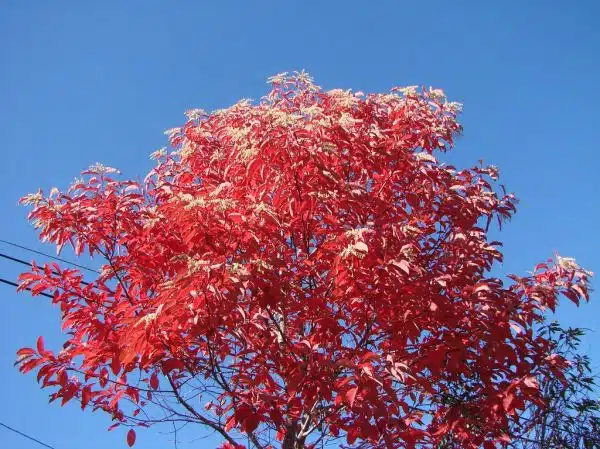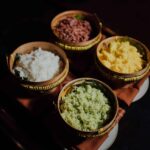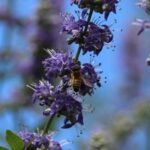The Sourwood Tree (Oxydendrum arboreum) is a native plant to the eastern region of North America. This tree species has been extensively used for its wood and medicinal properties, and it’s also known for its beautiful appearance during the fall season. As a sourwood tree expert, I have come across various communities that seek knowledge about this tree species. Hence, this article aims to provide an in-depth guide on the Sourwood Tree, including its history, characteristics, cultivation, and uses.
The Sourwood Tree is a unique plant that stands out from other trees due to its outstanding features. Its leaves turn red during the fall season and produce delicate white flowers in summer, which attracts bees and butterflies. The tree bark has a rough texture with furrows running vertically along its trunk. The wood from this tree species is commonly used for making furniture and musical instruments due to its high density and durability. Furthermore, several traditional medicines are derived from various parts of the sourwood tree due to their antibacterial properties. In this guide, we will explore these characteristics in detail while providing information on how best to cultivate and preserve this magnificent tree species.
History And Origins Of The Sourwood Tree
The sourwood tree, also known as oxydendrum arboreum, is a native plant of eastern North America. Its range extends from southern Pennsylvania to northern Florida and as far west as eastern Texas. Interestingly, this species has been found growing at elevations up to 5,000 feet in the Appalachian Mountains.
The origins of the sourwood tree can be traced back to the last ice age when it migrated southward along with other flora and fauna. The species is believed to have evolved in the southeastern United States over 50 million years ago. As for cultural significance, Native American tribes revered the sourwood tree for its medicinal properties and used it to treat various ailments such as coughs and colds. Additionally, folklore suggests that honey produced by bees feeding on sourwood blossoms has a superior flavor compared to other types of honey.
Today, the sourwood tree remains an important component of eastern forest ecosystems due to its ecological role in supporting pollinators and providing food and shelter for wildlife. Despite its cultural significance and ecological importance, this species remains relatively uncommon in cultivation outside of its native range. In the following sections, we will explore the unique characteristics that make this tree so special.
Characteristics Of The Sourwood Tree
The Sourwood tree, scientifically known as Oxydendrum arboreum, is an iconic tree of the eastern United States. It can grow up to 50 feet tall and has a narrow crown that spreads as it matures. The bark of the tree is smooth and gray, which becomes furrowed with age.
The Sourwood tree has several ecological uses. It is a great source of nectar for bees in late summer when other nectar sources are scarce. The leaves of the tree are also a food source for several species of insects and caterpillars. In addition, the wood from the tree is used for making furniture and tool handles.
Apart from its ecological uses, the Sourwood tree also has medicinal properties. Native Americans have used the bark of the tree to treat diarrhea and dysentery. Moreover, tea made from the leaves of this plant is believed to have antiseptic properties that help with sore throats and mouth ulcers.
Moving forward, we will explore the leaves and flowers of the sourwood tree in detail. The leaves turn a beautiful red color in autumn before falling off. They are long and pointed, measuring up to 8 inches long and 2 inches wide. On the other hand, the flowers bloom in late spring or early summer, producing clusters of white bell-shaped flowers that hang down from branches like chandeliers. These flowers are not only visually appealing but also provide an excellent source of nectar for bees and hummingbirds during their migration period.
Leaves And Flowers Of The Sourwood Tree
The leaves of the sourwood tree are deciduous and alternate, measuring around 5-8 inches long. They have an elliptical shape with serrated edges and a glossy green color that turns into a bright red hue during autumn. As the seasonal changes occur, the leaves become more vibrant, adding to the tree’s aesthetic value.
The flowers of the sourwood tree bloom in mid-summer, producing small white drooping clusters that are about 4-10 inches long. These flowers serve as a source of nectar for pollinators such as bees and butterflies. The sweet nectar also attracts wildlife like birds that feed on them.
In addition to their aesthetic beauty, the leaves and flowers of the sourwood tree play a crucial ecological role as it serves as an essential food source for various wildlife species like caterpillars and birds. The following are some benefits of the leaves and flowers of the sourwood tree:
- Provides an excellent source of nectar for pollinators, especially bees.
- Plays a crucial role in sustaining various wildlife species.
- Adds value to landscapes as it enhances aesthetic appeal.
As we move on to our next section about bark and trunk of the sourwood tree, let us explore how these parts contribute to its overall health and vitality.
Bark And Trunk Of The Sourwood Tree
The leaves and flowers of the sourwood tree are undoubtedly beautiful, but its bark and trunk also have unique features worth noting. The bark texture of the sourwood tree is quite distinctive, with deep furrows running vertically along the tree’s surface. This texture can be used to identify the tree from a distance and serves as a helpful tool in distinguishing it from other species.
In addition to its distinct bark texture, the age of a sourwood tree can be estimated by examining its trunk. As a tree ages, it develops growth rings that can be counted to determine its age. This method is not always accurate, but it provides an estimate that is often within a few years of the true age.
Overall, the bark and trunk of the sourwood tree provide valuable insights into its life cycle and characteristics. These features are just as important as its leaves and flowers and provide useful information for those interested in studying or identifying this native plant species.
| Bark Texture | Trunk Age Estimation |
|---|---|
| Deep furrows | Growth ring counting |
| Vertical pattern | Often within a few years accuracy |
| Distinctive feature | Useful tool for identifying species |
As we move forward in our exploration of the sourwood tree, it’s essential to note that understanding this plant’s wood uses and properties is equally important. From furniture-making to fuel production, many industries rely on this native plant species for various purposes. In the next section, we’ll delve into these uses and explore how they contribute to our daily lives.
Wood Uses And Properties Of The Sourwood Tree
One of the most impressive features of the sourwood tree is its strong and durable wood, which has great potential for use in various woodworking projects. However, some may argue that harvesting these trees for their timber can have a negative impact on the environment. While it is true that overharvesting can lead to ecological damage, responsible and sustainable practices can ensure that this resource is used without causing harm.
Sourwood wood has a beautiful light color with contrasting dark streaks, making it highly desirable for aesthetic purposes. It is commonly used for furniture, flooring, and decorative items. In addition to its visual appeal, sourwood wood is also known for its strength and resistance to decay. This makes it a popular choice for outdoor structures such as decks and fences.
To ensure that the ecological impact of harvesting sourwood trees remains minimal, sustainable forestry practices are essential. These include selective logging techniques and replanting programs. Additionally, using alternative materials or salvaged wood whenever possible can help reduce the demand for freshly harvested timber from any source. By doing so, we can enjoy the benefits of sourwood wood while also being mindful of our impact on the environment.
As we have seen, sourwood trees offer an abundance of resources beyond their beautiful blooms and sweet nectar. From their strong and durable wood to their potential medicinal properties (discussed in the subsequent section), this native plant has much to offer us. By taking care to use these resources responsibly and sustainably, we can continue to benefit from them long into the future.
Medicinal Properties Of The Sourwood Tree
The sourwood tree has been used for its medicinal applications for centuries. The Cherokee people, for instance, have traditionally used the leaves and bark of the tree to treat various ailments. The sourwood tree is known to possess anti-inflammatory and analgesic properties which make it effective in treating pain and inflammation.
The health benefits of the sourwood tree are numerous. Its leaves are rich in antioxidants that help protect the body from free radicals that can cause cellular damage. This makes it useful in preventing diseases such as cancer, heart disease, and Alzheimer’s disease. The tree’s antibacterial properties also make it useful in treating infections caused by bacteria.
In addition to its medicinal applications and health benefits, cultivating the sourwood tree can be a rewarding experience. With its beautiful foliage and fall coloration, it can be a great addition to any garden or landscape. Furthermore, cultivating this native plant helps preserve its natural habitat and contributes to biodiversity. In the subsequent section, we will explore how to successfully cultivate this remarkable plant.
Cultivating The Sourwood Tree
As we have learned in the previous section, the sourwood tree has various medicinal properties. But did you know that it is also an excellent addition to your garden? Not only does it produce beautiful flowers and autumn foliage, but it is also relatively low maintenance. One way to incorporate this tree into your gardening plans is through container gardening.
Container gardening offers a practical solution for those with limited space or poor soil quality. When cultivating a sourwood tree in a container, ensure that the pot has drainage holes to prevent water from pooling and causing damage to the roots. The ideal soil for the sourwood tree is acidic, well-draining, and rich in organic matter. You can create this by mixing equal parts of peat moss, perlite or vermiculite, and pine bark.
If you prefer planting directly into the ground, make sure to select a location with well-draining soil that is slightly acidic (pH 5-6). Avoid planting in areas prone to standing water or compacted soil as this may cause root rot or stunted growth. Amend the soil with organic matter such as compost or leaf mold before planting to improve drainage and fertility. Additionally, perform a soil test to determine if any nutrients are lacking and amend accordingly. By providing optimal growing conditions for your sourwood tree, you can ensure its longevity and health.
As with any plant, proper pruning and maintenance are essential for promoting healthy growth and preventing disease or pest infestations. In the subsequent section, we will delve deeper into these practices and provide guidance on when and how to prune your sourwood tree effectively.
Pruning And Maintenance Of The Sourwood Tree
Proper pruning techniques are essential for maintaining a healthy and attractive sourwood tree. When pruning, it’s important to remove diseased, damaged or dead branches. This will not only improve the appearance of the tree but also enhance its overall health. Pruning should be done annually, during the dormant season, to minimize damage to the tree.
Another important aspect of maintaining a healthy sourwood tree is disease prevention. The most common disease affecting this species is powdery mildew, which can cause leaves to turn yellow or brown and fall prematurely. To prevent this disease from spreading, it’s important to keep the area around the tree free from debris and ensure proper air circulation between branches.
To further enhance the health and growth of your sourwood tree, consider implementing these maintenance practices:
- Fertilize with a slow-release fertilizer in early spring
- Water deeply during periods of drought
- Mulch around the base of the tree to retain moisture and suppress weeds
By practicing proper pruning techniques and disease prevention methods along with regular maintenance practices, you can help preserve the beauty and health of your sourwood tree for years to come.
Preserving the Sourwood Tree for Future Generations
The sourwood tree is not only a beautiful addition to any landscape but also an important part of our natural ecosystem. As responsible stewards of our environment, it’s essential that we take steps to preserve this valuable species for future generations.
In the next section, we will discuss ways in which you can contribute to preserving this remarkable plant through conservation efforts and sustainable practices.
Preserving The Sourwood Tree For Future Generations
Pruning and Maintenance of the Sourwood Tree is crucial for its survival and longevity. As a native plant to North America, it plays an important role in the natural ecosystem, providing food and shelter for various wildlife. To ensure that the sourwood tree thrives for future generations to come, preserving it must be a priority.
Community involvement is key in conservation efforts for the sourwood tree. By educating the public about the importance of this tree and encouraging them to take action, we can increase awareness and promote its preservation. This can be achieved through workshops, seminars, and community events focused on environmental conservation.
In addition to community involvement, there are various conservation efforts that can be implemented to preserve the sourwood tree. These include protecting its natural habitat from destruction or degradation, implementing sustainable forestry practices, and preventing invasive species from overtaking its growth. By taking these measures, we can ensure that future generations will have the opportunity to appreciate the beauty and significance of this unique tree in North America’s natural ecosystem.
Table: Benefits of Preserving Sourwood Trees
| Benefit | Description |
|---|---|
| Biodiversity | Provides habitat and food source for wildlife |
| Carbon Sequestration | Absorbs carbon dioxide from atmosphere |
| Aesthetic Value | Adds beauty to landscapes |
| Medicinal Properties | Contains compounds with potential health benefits |
As we have seen, preserving the sourwood tree is essential for maintaining biodiversity in North America’s natural ecosystem. Through community involvement and conservation efforts, we can ensure that this unique species continues to thrive for years to come. Its benefits extend beyond aesthetic value as it plays a significant role in carbon sequestration and has potential medicinal properties. It is our responsibility as stewards of the environment to prioritize its preservation for future generations.
Conclusion: The Importance of Sourwood Trees in North America’s Natural Ecosystem will delve deeper into why preserving this species is critical not only for the environment but also for human health and well-being.
Conclusion: The Importance Of The Sourwood Tree In North America’s Natural Ecosystem
The sourwood tree plays an important role in North America’s natural ecosystem. One of its most significant contributions is in pollination. The sweet nectar produced by the tree’s flowers attracts bees, which in turn spread the pollen from flower to flower. This process not only ensures that the sourwood tree reproduces but also provides essential nutrients to other plants and animals within the ecosystem.
Moreover, the ecological role of sourwood trees cannot be overstated. As a native plant species, it has adapted to thrive in forest communities across North America. The leaves of the sourwood tree contain tannins, which help deter herbivores from feeding on them. This means that other plants nearby can grow without being consumed by insects or animals that would otherwise eat them.
In conclusion, the importance of sourwood trees in North America’s natural ecosystem cannot be overstated. Their contribution to pollination and their ecological role in forest communities are critical components that benefit numerous species within the ecosystem. Without this native plant species, many other plants and animals may struggle to survive and thrive in their natural habitat.
Conclusion
The Sourwood Tree, scientifically known as Oxydendrum Arboreum, is a native plant in North America that has been revered for its ecological and cultural significance. The tree’s history dates back to the early 1700s when it was first discovered by European settlers in the Appalachian Mountains. The Sourwood Tree’s unique characteristics have made it a popular choice for landscaping and preserving the natural ecosystem.
The Sourwood Tree is distinguished by its glossy green leaves that turn crimson red during autumn, and its beautiful white flowers that bloom in late summer. Its bark is smooth and grayish-brown which eventually transforms into rough and scaly as it ages. The tree’s wood is durable, light-weight, and has been used to make various items such as tool handles, furniture, and musical instruments.
Cultivating the Sourwood Tree requires excellent soil drainage and partial shade. Pruning is necessary to maintain its shape, remove damaged branches or cross limbs. As a native plant guide, I encourage everyone to preserve the Sourwood Tree for future generations. This tree plays an essential role in the natural ecosystem by providing food for bees and attracting other wildlife species such as birds and butterflies.
In conclusion, the Sourwood Tree holds great ecological importance in North America’s natural environment. Its unique features have captivated many people throughout history while contributing significantly to our cultural heritage. Preserving this magnificent tree will ensure that future generations can continue to enjoy its beauty while benefiting from its ecological significance. So let us all take up arms in protecting this precious gem of nature’s bounty!
Image Credits
- “Looking up at a sourwood tree, peak color, off NC 215, N of BRP” by Martin LaBar (featured)





























